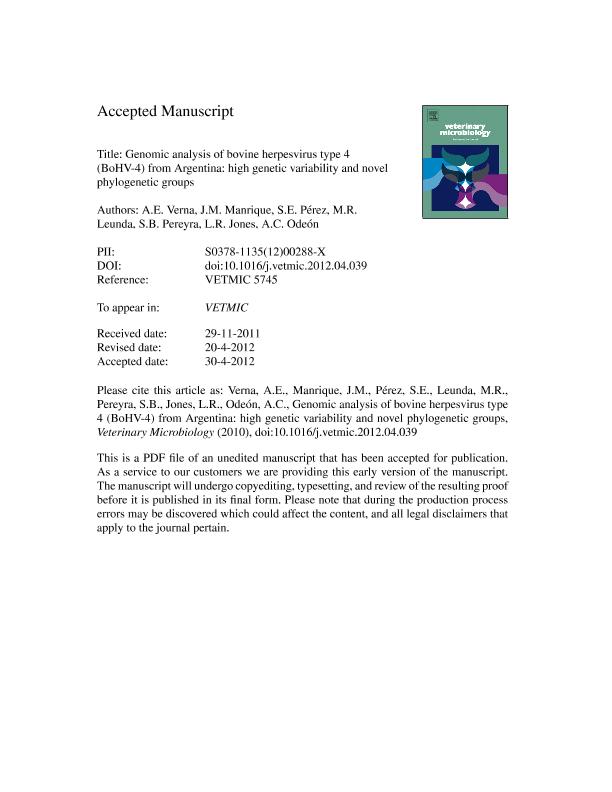Artículo
Genomic analysis of bovine herpesvirus type 4 (BoHV-4) from Argentina: High genetic variability and novel phylogenetic groups
Verna, Andrea Elizabeth ; Manrique, Julieta Marina
; Manrique, Julieta Marina ; Pérez, Sandra Elizabeth; Leunda, M. R.; Pereyra, Susana Beatriz; Jones, Leandro Roberto
; Pérez, Sandra Elizabeth; Leunda, M. R.; Pereyra, Susana Beatriz; Jones, Leandro Roberto ; Odeón, Anselmo Carlos
; Odeón, Anselmo Carlos
 ; Manrique, Julieta Marina
; Manrique, Julieta Marina ; Pérez, Sandra Elizabeth; Leunda, M. R.; Pereyra, Susana Beatriz; Jones, Leandro Roberto
; Pérez, Sandra Elizabeth; Leunda, M. R.; Pereyra, Susana Beatriz; Jones, Leandro Roberto ; Odeón, Anselmo Carlos
; Odeón, Anselmo Carlos
Fecha de publicación:
11/2012
Editorial:
Elsevier Science
Revista:
Veterinary Microbiology
ISSN:
0378-1135
Idioma:
Inglés
Tipo de recurso:
Artículo publicado
Clasificación temática:
Resumen
Bovine herpesvirus 4 (BoHV-4) is a γ-herpesvirus that has been isolated both from apparently healthy animals and from cattle with a variety of clinical signs, including post-partum endometritis and abortion. BoHV-4 causes either a persistent or a latent infection in cells of the monocyte/macrophage lineage. Two groups of BoVH-4 strains have been defined based on their restriction patterns: the Movar-like strains (European prototype) and the DN 599-like strains (American prototype). The purpose of the present study was to genetically characterize wild type BoHV-4 strains isolated from vaginal discharges of aborted cows in Argentina. The virus was identified by isolation and nested PCR in all vaginal discharge samples from aborted cows, either as a sole agent or in association with other pathogens. Restriction enzyme profiling and phylogenetic analysis demonstrated that there is a high genetic variability among the studied field isolates. The existence of three groups of strains, which were designated as genotypes 1, 2 and 3, is described. Genotypes 1 and 2 possibly correspond to the Movar-like and DN 599-like groups, respectively, whereas Genotype 3 corresponds to a novel group. Two viral strains did not cluster into any of these three groups, indicating that other genotypes could be circulating in Argentina. These results suggest a complex epidemiological background for the Argentinean BoHV-4 strains, probably influenced by independent events of genetic drift. This hypothesis cannot be rejected based on the available data. However, there is no direct evidence supporting this possibility. Thus, it seems speculative to suggest that interspecific jumps are responsible for the observed phylogenetic grouping. On the other hand, our analyses suggest a geographical structure for the observed viral genotypes, since genotypes 1 and 2 included the European (Movar-like) and American (DN599-like) reference strains, respectively. Geographic dispersion is known to be a driver of herpes viruses diversification, and independent evolution in geographical isolated places ensures the emergence of particular mutations in each location due to genetic drift (Compans, 2007; Zong et al., 1999). Therefore, at this point, the genetic drift hypothesis is the one that requires less ad-hoc considerations and thus, to our understanding, is the one that fits to the findings from this study. The involvement of this genetic variability in the detection and pathogenesis of BoHV-4 remains to be investigated.
Archivos asociados
Licencia
Identificadores
Colecciones
Articulos(SEDE CENTRAL)
Articulos de SEDE CENTRAL
Articulos de SEDE CENTRAL
Citación
Verna, Andrea Elizabeth; Manrique, Julieta Marina; Pérez, Sandra Elizabeth; Leunda, M. R.; Pereyra, Susana Beatriz; et al.; Genomic analysis of bovine herpesvirus type 4 (BoHV-4) from Argentina: High genetic variability and novel phylogenetic groups; Elsevier Science; Veterinary Microbiology; 160; 1-2; 11-2012; 1-8
Compartir
Altmétricas



